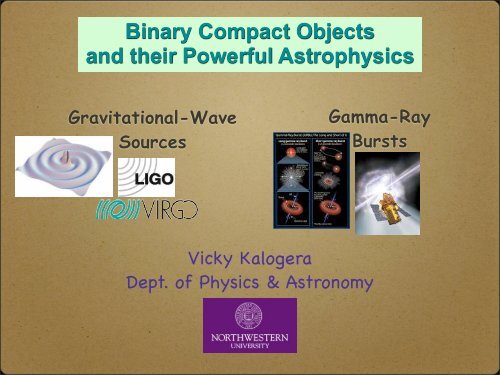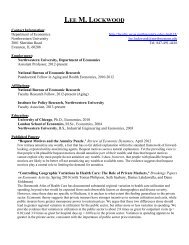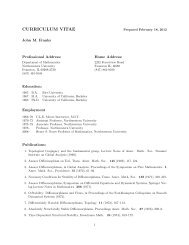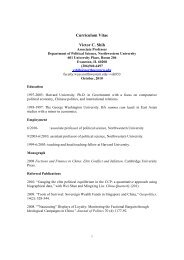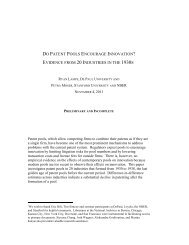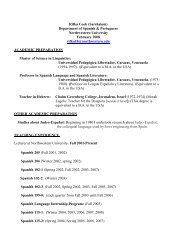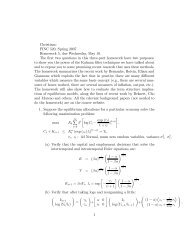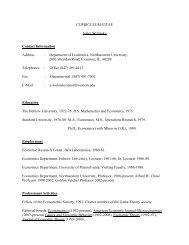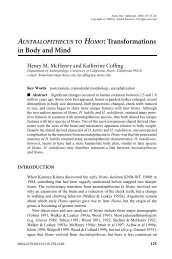Binary Compact Objects and their Powerful ... - Northwestern
Binary Compact Objects and their Powerful ... - Northwestern
Binary Compact Objects and their Powerful ... - Northwestern
Create successful ePaper yourself
Turn your PDF publications into a flip-book with our unique Google optimized e-Paper software.
Gravitational Wavesspacetime deformationsare communicatedthrough gravitationalwaves:Mass curves spacetime<strong>and</strong> affects distances betweenreference pointstransverse wavespropagatingat the speed of light
Gravitational RadiationSource:moment tensor I jk :Time-dependent mass quadrupoleAmplitude:
The Effect of Gravitational Waves
The Effect of Gravitational Wavestranserve-wave oscillatory disturbances ofreference (undisturbed) spacetimequadrupole nature: 2 polarizations at 45 degree angle
The Effect of Gravitational Wavestranserve-wave oscillatory disturbances ofreference (undisturbed) spacetimequadrupole nature: 2 polarizations at 45 degree angle
The Effect of Gravitational Wavesvery weak:ideally: highly compact, fast moving, nearby objects
The Effect of Gravitational Wavesvery weak:ideally: highly compact, fast moving, nearby objectsdirect detection goal:measure relative distance changes
The Effect of Gravitational Wavesvery weak:ideally: highly compact, fast moving, nearby objectsdirect detection goal:measure relative distance changesBlack Hole of 10 solar masses moving at the speed of lightlocated at the Galactic center: h ~ 10 -17at the nearest major cluster of galaxies: h ~ 10 -20
The Effect of Gravitational Wavesvery weak:ideally: highly compact, fast moving, nearby objectsdirect detection goal:measure relative distance changesBlack Hole of 10 solar masses moving at the speed of lightlocated at the Galactic center: h ~ 10 -17at the nearest major cluster of galaxies: h ~ 10 -20challenging, but we know gravitational wavesare real ...
Do Gravitational Waves Really Exist?Hulse-Taylor <strong>Binary</strong> Pulsar: The first relativistic binary pulsar
Do Gravitational Waves Really Exist?Hulse-Taylor <strong>Binary</strong> Pulsar: The first relativistic binary pulsarA binary system with two neutron stars,one or two of which emit radio pulses:
Do Gravitational Waves Really Exist?Hulse-Taylor <strong>Binary</strong> Pulsar: The first relativistic binary pulsarA binary system with two neutron stars,one or two of which emit radio pulses:Rate of orbital decay consistent withgravitational wave losses within 0.3% !Orbital Decay RateWeisberg & Taylor 2003Year
Do Gravitational Waves Really Exist?Hulse-Taylor <strong>Binary</strong> Pulsar: The first relativistic binary pulsarA binary system with two neutron stars,one or two of which emit radio pulses:Rate of orbital decay consistent withgravitational wave losses within 0.3% !Orbital Decay RateWeisberg & Taylor 2003Year4 more relativistic NS-NS have been discovered,one of them is a double pulsar, the most relativistic NS-NS so far!GR tested <strong>and</strong> confirmed at < 0.05 % (Burgay et al, Lyne et al, Kramer et al)
How about direct detection?LIGOGEOVirgoTAMAAIGO
How about direct detection?Coincidence:detection confidencesource localizationLIGOGEOVirgoTAMAAIGO
How about direct detection?Laser Interferometry
LIGO sensitivity
LIGO sensitivity
LIGO sensitivity
LIGO sensitivity
Studies of <strong>Binary</strong> <strong>Compact</strong> <strong>Objects</strong>Some questions of interest ...How do they form ?What are the expected ratesfor LIGO detections ?How do you detect & decode such weak signals?
<strong>Compact</strong> <strong>Binary</strong> Inspiral: Event RatesTwo main paths for rate estimation
<strong>Compact</strong> <strong>Binary</strong> Inspiral: Event RatesTwo main paths for rate estimationEmpiricalfrom the knownGalactic binary pulsarsonly for NS-NSinspirals
<strong>Compact</strong> <strong>Binary</strong> Inspiral: Event RatesTwo main paths for rate estimationEmpiricalfrom the knownGalactic binary pulsarsonly for NS-NSinspiralsTheoreticalfrom our underst<strong>and</strong>ingof binary star evolutionfor NS-NSNS-BH & BH-BHinspirals
<strong>Compact</strong> <strong>Binary</strong> Inspiral: Event RatesEmpirical Rate EstimatesVK et al 2001, 2004Kim et al 2003, 2008Burgay et al 2003large statistical uncertainty:factor of ~50 at 99% C.I.PDF has a clear peak with tailfactor of ~5 at 68% C.Isystematic uncertainty:factor of ~20
<strong>Compact</strong> <strong>Binary</strong> Inspiral: Event RatesEmpirical Rate EstimatesVK et al 2001, 2004Kim et al 2003, 2008Burgay et al 2003large statistical uncertainty:factor of ~50 at 99% C.I.PDF has a clear peak with tailfactor of ~5 at 68% C.Isystematic uncertainty:factor of ~20
<strong>Compact</strong> <strong>Binary</strong> Inspiral Rates:What about Black Hole Binaries?
<strong>Compact</strong> <strong>Binary</strong> Inspiral Rates:What about Black Hole Binaries?No BH-NS or BH-BH known from E&M observationsSo far, inspiral rate predictionsonly from population calculationswith uncertainties of ~ 3 orders of mag
<strong>Compact</strong> <strong>Binary</strong> Inspiral Rates:What about Black Hole Binaries?No BH-NS or BH-BH known from E&M observationsSo far, inspiral rate predictionsonly from population calculationswith uncertainties of ~ 3 orders of magWe can use NS-NS empirical rates as constraintson population synthesis modelsO’Shaughnessy et al 2005, 2007, 2008
<strong>Compact</strong> <strong>Binary</strong> Inspiral Rates:Empirical Constraints onPopulation Model PredictionsO’Shaughnessy et al 2005, 2007, 2008Select models that satisfy empirical constraintsObtain rate predictions for BH binaries
<strong>Compact</strong> <strong>Binary</strong> Inspiral Rates:Current PredictionsLSC - CBC Rates Document 2008
<strong>Compact</strong> <strong>Binary</strong> Inspiral Rates:Current Predictions@ peak probabilityLSC - CBC Rates Document 2008
<strong>Compact</strong> <strong>Binary</strong> Inspiral Rates:Current Predictions@ peak probabilitywithrealisticoptimismLSC - CBC Rates Document 2008
<strong>Compact</strong> <strong>Binary</strong> Inspiral Rates:Current Predictions@ peak probabilitywithrealisticoptimismLSC - CBC Rates Document 2008
<strong>Compact</strong> <strong>Binary</strong> Inspiral Rates:Current Predictions@ peak probabilitywithrealisticoptimismLSC - CBC Rates Document 2008
<strong>Compact</strong> <strong>Binary</strong> Inspiral Rates:Current Predictions@ peak probabilitywithrealisticoptimismLSC - CBC Rates Document 2008
<strong>Compact</strong> <strong>Binary</strong> Inspiral Rates:Current PredictionsWhat is the probability that one or more inspiralswill be detected by enhanced LIGO?
Probability<strong>Compact</strong> <strong>Binary</strong> Inspiral Rates:Current PredictionsWhat is the probability that one or more inspiralswill be detected by enhanced LIGO?O’Shaughnessy et al 2009
Going Beyond GW Detection ...Gravitational Wave Astronomy
Going Beyond GW Detection ...Gravitational Wave AstronomyThe challenge of GW detectionis clear <strong>and</strong> formidable ...
Going Beyond GW Detection ...Gravitational Wave AstronomyThe challenge of GW detectionis clear <strong>and</strong> formidable ...... but progress in astrophysics needs- (accurate) measurements of the physical propertiesof GW sources- systematic studies of source samples
Going Beyond GW Detection ...Gravitational Wave AstronomyThe challenge of GW detectionis clear <strong>and</strong> formidable ...... but progress in astrophysics needs- (accurate) measurements of the physical propertiesof GW sources- systematic studies of source samplesGiven how weak <strong>and</strong> rareGW sources arethe challenge of physicalparameter estimationis not to be ignored ...S/N ~ 17
Gravitational Wave Astronomy:Physical Parameter Estimation
Gravitational Wave Astronomy:Physical Parameter EstimationThe case ofNS-BH inspiralwith spinning BH:12 parameters!
Gravitational Wave Astronomy:Physical Parameter Estimationnon-spinning chirpThe case ofNS-BH inspiralwith spinning BH:12 parameters!
Gravitational Wave Astronomy:Physical Parameter EstimationExample MCMC run ( van der Sluys et al. 2008 )signal injected:MCMC:Sampling theposterior PDF of the“chirp mass”~3 days on a single 2.8GHz CPUaccuracy of 0.5%
Gravitational Wave Astronomy:Physical Parameter EstimationExample MCMC run ( van der Sluys et al. 2008 )signal injected:MCMC:Sampling theposterior PDF of the“chirp mass”~3 days on a single 2.8GHz CPUaccuracy of 0.5%
Gravitational Wave Astronomy:Physical Parameter EstimationMajor difficulties:large number of parameters (12 -15)relatively low S/N (~10)strong correlations among parametersvan der Sluys et al. 2008, Raymond et al 2009
Gravitational Wave Astronomy:Physical Parameter EstimationMajor difficulties:large number of parameters (12 -15)relatively low S/N (~10)strong correlations among parametersvan der Sluys et al. 2008, Raymond et al 2009
Gravitational Wave Astronomy:Physical Parameter EstimationMajor difficulties:large number of parameters (12 -15)relatively low S/N (~10)strong correlations among parametersvan der Sluys et al. 2008, Raymond et al 2009
<strong>Binary</strong> <strong>Compact</strong> <strong>Objects</strong>Powering Gamma Ray Bursts ?
<strong>Binary</strong> <strong>Compact</strong> <strong>Objects</strong>Powering Gamma Ray Bursts ?Some of the basics ...Most luminous E&Msince the Big Bang:Gamma-ray flashesof 0.1 - 100 secshort (2sec)
<strong>Binary</strong> <strong>Compact</strong> <strong>Objects</strong>Powering Gamma Ray Bursts ?Some of the basics ...Most luminous E&Msince the Big Bang:Gamma-ray flashesof 0.1 - 100 secCoordinated E&M observations(X-ray, optical, infrared, radio)reveal clues about progenitorsshort (2sec)
<strong>Binary</strong> <strong>Compact</strong> <strong>Objects</strong>Powering Gamma Ray Bursts ?Some of the basics ...Most luminous E&Msince the Big Bang:Gamma-ray flashesof 0.1 - 100 secshort (2sec)
<strong>Binary</strong> <strong>Compact</strong> <strong>Objects</strong>Powering Gamma Ray Bursts ?Some of the basics ...Most luminous E&Msince the Big Bang:Gamma-ray flashesof 0.1 - 100 secshort (2sec)central BHaccretingfrom gas toruswith jets
<strong>Binary</strong> <strong>Compact</strong> <strong>Objects</strong>Powering Gamma Ray Bursts ?Identification of GRB host galaxies is crucialfor revealing <strong>their</strong> nature <strong>and</strong> progenitors
<strong>Binary</strong> <strong>Compact</strong> <strong>Objects</strong>Powering Gamma Ray Bursts ?Identification of GRB host galaxies is crucialfor revealing <strong>their</strong> nature <strong>and</strong> progenitorsLong GRB
<strong>Binary</strong> <strong>Compact</strong> <strong>Objects</strong>Powering Gamma Ray Bursts ?Identification of GRB host galaxies is crucialfor revealing <strong>their</strong> nature <strong>and</strong> progenitorsLong GRBalways found in galaxieswith very active star formation<strong>and</strong> young stellar populations
<strong>Binary</strong> <strong>Compact</strong> <strong>Objects</strong>Powering Gamma Ray Bursts ?Identification of GRB host galaxies is crucialfor revealing <strong>their</strong> nature <strong>and</strong> progenitorsLong GRBalways found in galaxieswith very active star formation<strong>and</strong> young stellar populationsmost often associatedwith optical supernovasignals
<strong>Binary</strong> <strong>Compact</strong> <strong>Objects</strong>Powering Gamma Ray Bursts ?Identification of GRB host galaxies is crucialfor revealing <strong>their</strong> nature <strong>and</strong> progenitorsLong GRBalways found in galaxieswith very active star formation<strong>and</strong> young stellar populationsmost often associatedwith optical supernovasignalscore collapse ofyoung, massive stars
<strong>Binary</strong> <strong>Compact</strong> <strong>Objects</strong>Powering Gamma Ray Bursts ?Identification of GRB host galaxies is crucialfor revealing <strong>their</strong> nature <strong>and</strong> progenitorsinitiallyLong GRBShort GRBalways found in galaxieswith very active star formation<strong>and</strong> young stellar populationsmost often associatedwith optical supernovasignalscore collapse ofyoung, massive stars
<strong>Binary</strong> <strong>Compact</strong> <strong>Objects</strong>Powering Gamma Ray Bursts ?Identification of GRB host galaxies is crucialfor revealing <strong>their</strong> nature <strong>and</strong> progenitorsLong GRBalways found in galaxieswith very active star formation<strong>and</strong> young stellar populationsShort GRBinitiallyTwo found in ellipticals,no star formation,old stellar populationsmost often associatedwith optical supernovasignalscore collapse ofyoung, massive stars
<strong>Binary</strong> <strong>Compact</strong> <strong>Objects</strong>Powering Gamma Ray Bursts ?Identification of GRB host galaxies is crucialfor revealing <strong>their</strong> nature <strong>and</strong> progenitorsLong GRBalways found in galaxieswith very active star formation<strong>and</strong> young stellar populationsmost often associatedwith optical supernovasignalsShort GRBinitiallyTwo found in ellipticals,no star formation,old stellar populationsno supernovaassociationscore collapse ofyoung, massive stars
<strong>Binary</strong> <strong>Compact</strong> <strong>Objects</strong>Powering Gamma Ray Bursts ?Identification of GRB host galaxies is crucialfor revealing <strong>their</strong> nature <strong>and</strong> progenitorsLong GRBalways found in galaxieswith very active star formation<strong>and</strong> young stellar populationsmost often associatedwith optical supernovasignalscore collapse ofyoung, massive starsShort GRBinitiallyTwo found in ellipticals,no star formation,old stellar populationsno supernovaassociationsNS-NS <strong>and</strong>/or BH-NS mergerswith long delay times betweenstar formation <strong>and</strong> merger
<strong>Binary</strong> <strong>Compact</strong> <strong>Objects</strong>Powering Gamma Ray Bursts ?Identification of GRB host galaxies is crucialfor revealing <strong>their</strong> nature <strong>and</strong> progenitorsinitiallyLong GRBcore collapse ofyoung, massive starsShort GRBNS-NS <strong>and</strong>/or BH-NS mergerswith long delay times betweenstar formation <strong>and</strong> merger
<strong>Binary</strong> <strong>Compact</strong> <strong>Objects</strong>Powering Gamma Ray Bursts ?Identification of GRB host galaxies is crucialfor revealing <strong>their</strong> nature <strong>and</strong> progenitorsinitiallyLong GRBcore collapse ofyoung, massive starshigh average redshift (~3):Short GRBNS-NS <strong>and</strong>/or BH-NS mergerswith long delay times betweenstar formation <strong>and</strong> merger@ large distances, early timeswhen star formation was highconsistent with short delays<strong>and</strong> short lifetimesof very massive stars (~Myr)
<strong>Binary</strong> <strong>Compact</strong> <strong>Objects</strong>Powering Gamma Ray Bursts ?Identification of GRB host galaxies is crucialfor revealing <strong>their</strong> nature <strong>and</strong> progenitorsinitiallyLong GRBcore collapse ofyoung, massive starshigh average redshift (~3):@ large distances, early timeswhen star formation was highconsistent with short delays<strong>and</strong> short lifetimesof very massive stars (~Myr)Short GRBNS-NS <strong>and</strong>/or BH-NS mergerswith long delay times betweenstar formation <strong>and</strong> mergerlow average redshift (~0.3):@ small distances, current timesconsistent with long delays(~5Gyr)
<strong>Binary</strong> <strong>Compact</strong> <strong>Objects</strong>Powering Short Gamma Ray Bursts ?initiallyShort GRBNS-NS <strong>and</strong>/or BH-NS mergerswith long delay times betweenstar formation <strong>and</strong> mergerlow average redshift (~0.3):@ small distances, current timesconsistent with long delays(~5Gyr)
<strong>Binary</strong> <strong>Compact</strong> <strong>Objects</strong>Powering Short Gamma Ray Bursts ?initiallyShort GRB But our theoretical models predicteddelay times: 10Myr - 10GyrNS-NS <strong>and</strong>/or BH-NS mergerswith long delay times betweenstar formation <strong>and</strong> mergerlow average redshift (~0.3):@ small distances, current timesconsistent with long delays(~5Gyr)Belczynski et al. 2001,2002a,bBelczynski et al. 2006
<strong>Binary</strong> <strong>Compact</strong> <strong>Objects</strong>Powering Short Gamma Ray Bursts ?Present Status:(Berger 2009, Nakar 2007, Berger et al 2007, 2008,Ofek et al 2008)
<strong>Binary</strong> <strong>Compact</strong> <strong>Objects</strong>Powering Short Gamma Ray Bursts ?Present Status:(Berger 2009, Nakar 2007, Berger et al 2007, 2008,Ofek et al 2008)`the majority of short GRBs appear to occur instar forming galaxies’ (at a 5:1 ratio)
<strong>Binary</strong> <strong>Compact</strong> <strong>Objects</strong>Powering Short Gamma Ray Bursts ?Present Status:(Berger 2009, Nakar 2007, Berger et al 2007, 2008,Ofek et al 2008)`the majority of short GRBs appear to occur instar forming galaxies’ (at a 5:1 ratio)L ~ 0.1 - 1.5 L*SFR ~ 0.2 - 6 Msun per yrZ ~ 0.6 - 1.6 solar
<strong>Binary</strong> <strong>Compact</strong> <strong>Objects</strong>Powering Short Gamma Ray Bursts ?Present Status:(Berger 2009, Nakar 2007, Berger et al 2007, 2008,Ofek et al 2008)`the majority of short GRBs appear to occur instar forming galaxies’ (at a 5:1 ratio)L ~ 0.1 - 1.5 L*SFR ~ 0.2 - 6 Msun per yrZ ~ 0.6 - 1.6 solarsample indicates that 1/3 of short GRBsare at redshifts > 1
<strong>Binary</strong> <strong>Compact</strong> <strong>Objects</strong>Powering Short Gamma Ray Bursts ?Present Status:(Berger 2009, Nakar 2007, Berger et al 2007, 2008,Ofek et al 2008)`the majority of short GRBs appear to occur instar forming galaxies’ (at a 5:1 ratio)L ~ 0.1 - 1.5 L*SFR ~ 0.2 - 6 Msun per yrZ ~ 0.6 - 1.6 solarsample indicates that 1/3 of short GRBsare at redshifts > 1A wide range of ages is favored, from~10-100Myr to 10 Gyr
<strong>Binary</strong> <strong>Compact</strong> <strong>Objects</strong>Powering Short Gamma Ray Bursts ?Population models for star formation in bothspirals <strong>and</strong> ellipticals with all available constraints:binary pulsar rates & GRB redshift distributionO’Shaughnessy et al 2008UNconstrainedconstrainedCumulative redshift distribution
<strong>Binary</strong> <strong>Compact</strong> <strong>Objects</strong>Powering Short Gamma Ray Bursts ?Population models for star formation in bothspirals <strong>and</strong> ellipticals with all available constraints:binary pulsar rates & GRB redshift distributionO’Shaughnessy et al 2008UNconstrainedconstraineda small numberof models survivesif all short GRBare NS-NS mergersCumulative redshift distribution
<strong>Binary</strong> <strong>Compact</strong> <strong>Objects</strong>Powering Short Gamma Ray Bursts ?Combining all available constraints on population models:binary pulsar rates & GRB redshift distributionO’Shaughnessy et al 2008UNconstrainedmore models surviveif all short GRBare NS-BH mergersconstrainedCumulative redshift distribution
<strong>Binary</strong> <strong>Compact</strong> <strong>Objects</strong>Powering Short Gamma Ray Bursts ?Combining all available constraints on population models:binary pulsar rates & GRB redshift distributionO’Shaughnessy et al 2008UNconstrainedmore models surviveif all short GRBare NS-BH mergersconstrainedBUT requiressignificantly highbirth spin for BHCumulative redshift distributionBelczynski et al 2008
<strong>Binary</strong> <strong>Compact</strong> <strong>Objects</strong>Powering Short Gamma Ray Bursts ?NS-NS or BH-NS?UNconstrainedFraction of spiral,star-forming hostsBH-NSNS-NSConstrainedO’Shaughnessy et al 2008, 2009
<strong>Binary</strong> <strong>Compact</strong> <strong>Objects</strong>Powering Short Gamma Ray Bursts ?
<strong>Binary</strong> <strong>Compact</strong> <strong>Objects</strong>Powering Short Gamma Ray Bursts ?
<strong>Binary</strong> <strong>Compact</strong> <strong>Objects</strong>Powering Short Gamma Ray Bursts ?Based on lots of consistent clues, yes ...but conclusive proof can only come frommulti-messenger astronomycoincident E&M <strong>and</strong> GW observations:gamma-ray burst <strong>and</strong> inspiral signal in gravitational waves!mass (<strong>and</strong> spin) measurements from LIGO/Virgocould also answer the questionNS-NS vs. NS-BH or both ?
Multi-Messenger Astronomy:the beginnings ...
Multi-Messenger Astronomy:the beginnings ...LIGO observations restrict GRB 070201 origin:
Multi-Messenger Astronomy:the beginnings ...LIGO observations restrict GRB 070201 origin:<strong>Binary</strong> Merger in M31 excludedat > 99% probabilityThe LIGO Scientific Collaboration & Hurley 2008, ApJ
NS <strong>and</strong> BH compact binaries:GW chirpsinspiral chirpf GW = 2xf orbGW emission causes orbitalshrinkage leading to higherGW frequency & amplitude
NS <strong>and</strong> BH compact binaries:GW chirpsinspiral chirpf GW = 2xf orbGW emission causes orbitalshrinkage leading to higherGW frequency & amplitude
GW Sources: High Frequency
<strong>Binary</strong> <strong>Compact</strong> <strong>Objects</strong>: Formationfrom Tauris & van den Heuvel 2003
<strong>Binary</strong> <strong>Compact</strong> <strong>Objects</strong>: FormationMassive primordial binaryMass-transfer #1: hydrostatically <strong>and</strong>thermally Stable,but Non-Conservative: mass <strong>and</strong> A.M. lossSupernova <strong>and</strong> NS Formation #1:Mass Loss <strong>and</strong> Natal KickHigh-mass X-ray <strong>Binary</strong>: NS Accretionfrom Massive Companion’s Stellar WindMass-transfer #3: Dynamically UnstableMass-tranfer #4: Possible <strong>and</strong> StableSupernova <strong>and</strong> NS Formation #2:Mass Loss <strong>and</strong> Natal KickDouble Neutron-Star Formed!from Tauris & van den Heuvel 2003
<strong>Binary</strong> <strong>Compact</strong> <strong>Objects</strong>: FormationQ: What is the origin of NS <strong>and</strong> BH ?
<strong>Binary</strong> <strong>Compact</strong> <strong>Objects</strong>: FormationQ: What is the origin of NS <strong>and</strong> BH ?A: Use properties of observed systems<strong>and</strong> derive physical constraints onNS, BH progenitors <strong>and</strong> stellar collapseDouble PulsarWillems et al. 2006, PRD


